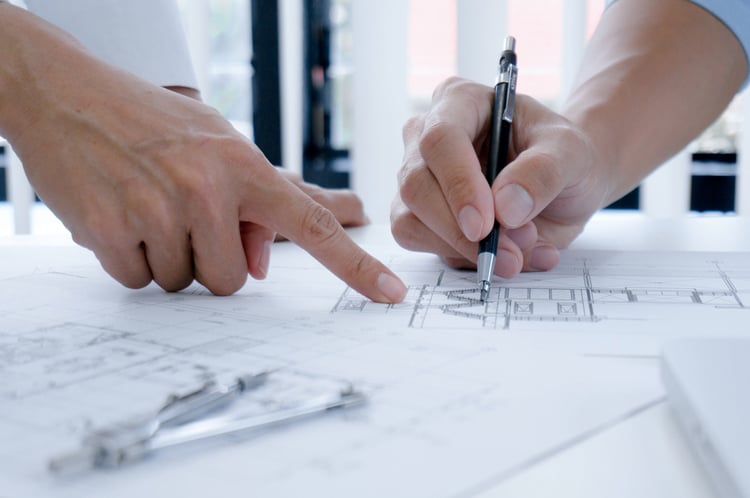Today, MEP engineering projects are an important trend driving a process of change in the construction industry, and for good reason. MEP integrations establish the link between the architect's design and engineering systems. The practice facilitates design changes and influences the building’s structural and architectural concepts. Choosing an MEP engineering design allows teams to recognize potential issues in the early stages of the project, reducing unexpected setbacks during construction. When done correctly, an architect can use the information provided in the initial MEP analysis to design the perfect layout for the building that will make the entire construction process go smoothly.
However, when it comes to designing MEP integrations , many architects skip essential steps that result in inefficiencies down the road. Because MEP integrations rely heavily on good design, it's crucial that architects know what they need to do to ensure successful delivery from the start. Using these tips as a checklist for your next MEP engineering project will help you minimize the risk of error and make sure every detail is taken into consideration.
Avoid costly delays on your next project. Review your MEP design before beginning construction to ensure successful delivery.
MEP Engineering Projects Overview 
The first step of an MEP Engineering Project involves evaluating the scope of services. Historically, mechanical, electrical, and plumbing systems fall into MEP categories. Today, technology plays a much larger role in the process – it is ingrained in every aspect of construction. MEP integrations now include fire protection systems, controls, process piping and data communications lines. MEP engineering and architectural design reviews identify potential problems before construction. The added value of MEP for the customer is a functional and economical structure.
The process begins with checking the architectural design model. Using the architect's design, engineers ensure that the architect's building design meets construction requirements. This step allows teams to identify potential failures or obstacles early, which greatly benefits the construction schedule. Without this step, these conditions could delay business schedules due to necessary revisions and time constraints. By performing this analysis upfront, the design team can ensure the delivered design is code compliant .
Common challenges in designing MEP integrations

Thanks to the advanced technologies available for MEP integrations, appropriately sized equipment can be identified in the early design phase. Engineering dimensions and space requirements are critical during the early stages of the project. Although it may seem like a small step, the cost savings generated from this information help keep the project within budget . In some cases, the architect may lose some design space to accommodate the equipment. In this situation, they would face the challenge of adjusting the design layout without affecting the building's engineering systems. The process allows suggested MEP integrations to be installed into building construction plans. These changes must be carried out without loss of function or safety.
Even small problems can turn into big problems. Issues such as placing equipment in the wrong location can have consequences on the structural design of the building. An example is equipment placed on the roof. Due to size and location, these systems may require structural reinforcement. Generally, refrigeration equipment placed on roofs has moving parts, which can cause noise and vibrations, requiring revisions to the building structure to accommodate the weight and noise. Structural revisions at any stage of the project can be a hassle. Early detection can reduce the cost of revisions and the amount of valuable work hours.
Like all industries, construction has a standard of quality and completeness of work. Construction problems are generally related to structural load capacities, system controls and safety regulations, but the most costly errors are errors linked to the project's larger applications. When rework is necessary, it is usually because the original designs and construction reviews missed the error. Continuous communications during project construction between engineering and the architect prevent costly modifications.
Early owner involvement
Preliminary work needs to involve the building owner. Involving the owner from the beginning is important so that architects can be sure their design meets the client's standards and avoid numerous revisions. For this reason, the owner's input is valuable in designing and planning a profitable project. Specifically with MEP integrations, the information generated from the initial MEP analysis provides a realistic cost of the project and potential changes. Based on MEP data, the building owner can make final decisions about project design and construction in the early stages, rather than later in the process when changes are more difficult and costly. By resolving these issues from the beginning, the value of the design increases.
Address any pre-existing conditions
All cities and states have code enforcement that requires pre-construction assessments of existing buildings. The assessment includes structural systems and MEP. Help for MEP integrations determine potential building constraints . However, not all pre-existing conditions are obvious. Building corridors, transparent walls, fire walls and ceiling types tend to hide the past. Conditions may include termite damage, dry rot, and mold and asbestos removal.
Coordinate with other team members

In MEP integration, the importance of clear communication with team members with different roles in the project lifecycle is often underestimated. Coordinating MEP engineers, synchronizing contractors, and updating project management is critical to keeping the project on track. The interplay of mindsets and approaches keeps everything running smoothly. MEP integrations include heating, ventilation and air conditioning (HVAC), plumbing and electrical systems. Before final drawings, the MEP project engineer prepares a detailed preliminary drawing. Final design reviews, technical specifications, and cost estimates are based on the analysis. The team ensures the final design is compliant and includes approved equipment checks. The engineering checklist preserves the building's planned systems without altering the architect's illustration.
Consider the cost-benefit ratio of the MEP project

To design to maximize value, MEP engineering projects must generate a cost ratio greater than 1. Basically, the formula explains why architects and MEP engineers are building structures faster. Current technology has introduced a method of adding modifications to modernize existing buildings. Using current technology, engineers are improving the building's internal systems. Modified results include longer equipment life cycles. The design process is not just limited to architecture. Urban planners, municipal authorities and engineers impact the final construction. The MEP architect and engineering teams ensure it is built to last. They are responsible for delivering the project on time and within budget. At the same time – customer expectations are met and future occupants are comfortable and safe.
Key Takeaways
Creating a design for MEP engineering projects is a complex process and there are many elements that must be considered to create a design that launches the project for success from the start. Some issues are technical, while others relate to industry standards, processes and practices. Follow these tips on your next project to increase your chances of successful results.
-
From time to time, teams need to realign themselves and find the best way to implement changes to the structure's design.
-
Forcing an engineering process into an existing condition is not always a viable solution.
-
MEP is adapting the technology to a specific set of projects and construction conditions.
Want to make sure your MEP Design is built for success? Request a free MEP value engineering project analysis and we will perform a detailed analysis of your project, locate any areas for improvement, and reduce your costs to minimum requirements.
Editor's Note: This post was originally published in November 2016 and has been reworked and updated for accuracy and comprehensiveness.

